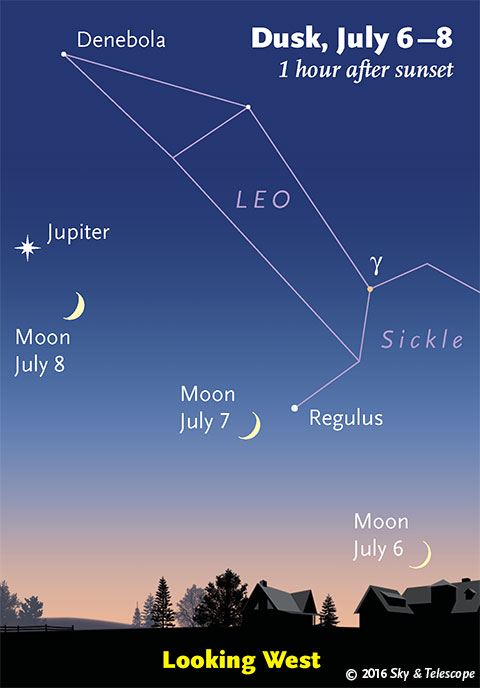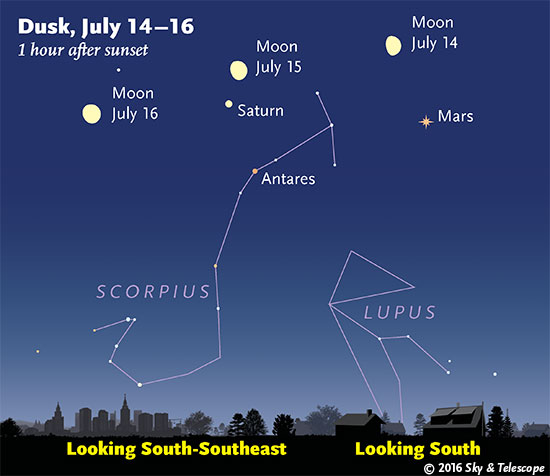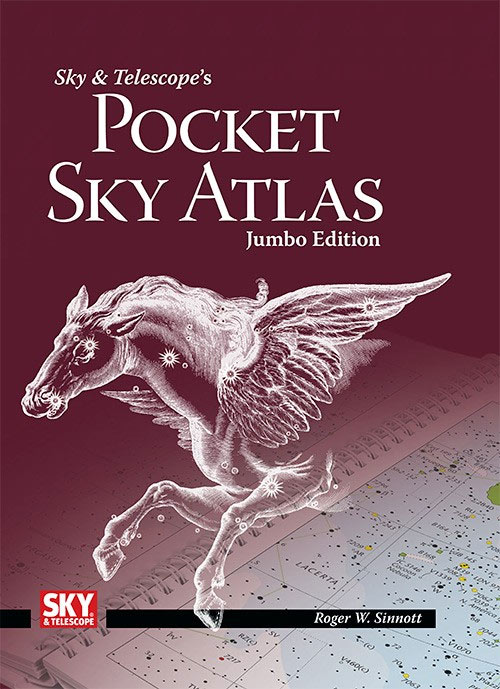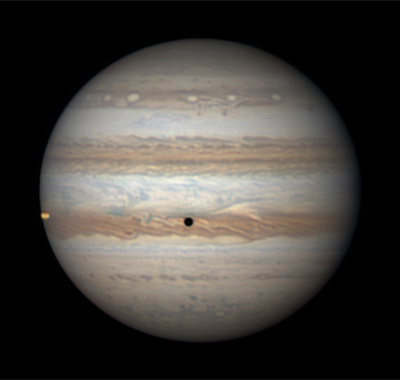
Friday, July 8
• The waxing crescent Moon shines in the west at dusk. Jupiter is the bright "star" some 3° or 4° upper left of it (for North America). When night arrives, look for Sigma Leonis, magnitude 4.0, glimmering 0.9° to Jupiter's upper left (not shown on the twilight chart here).
Saturday, July 9
• Jupiter now shines to the Moon's lower right during and after dusk. The Moon is 1.3 light-seconds away; Jupiter this week is 49 light-minutes away, 2,200 times farther.
Sunday, July 10
• After nightfall, Altair shines in the east-southeast. It's the second-brightest star on the eastern side of the sky, after Vega very high to its upper left.
Look above Altair by a finger-width at arm's length for little orange Tarazed. A bit more than a fist-width to Altair's lower left is Delphinus, the Dolphin, leaping leftward below the Milky Way.
Monday, July 11
• First-quarter Moon (exact at 8:52 p.m. EDT). As twilight fades, watch for 1st-magnitude Spica emerging into view about 6° to the Moon's lower left (as seen during the twilight times for North America).
Tuesday, July 12
• As soon as it's dark, look just ½° north (upper right) of Jupiter for 4th-magnitude Sigma Leonis, Leo's hind foot. Tonight they're the closest they will appear.
Wednesday, July 13
• The Big Dipper, high in the northwest after dark, is now turning around to "scoop up water" through the evenings of summer and early fall.
Thursday, July 14
• The Moon, in its monthly cycle around the sky, once again forms a long, squashed rectangle with Mars, Saturn and Antares. Mars shines below the Moon after dusk, Saturn glows farther to the Moon's left, and under Saturn is Antares — as shown in the slightly earlier twilight scene below.

Friday, July 15
• Tonight the Moon, Saturn, and Antares form a roughly vertical stack in the south at dusk, as shown above, with Mars off to their right. Watch them all tilt westward until they set around 2 to 3 a.m.
Saturday, July 16
• Venus-Mercury conjunction challenge: About 15 minutes after sunset, use binoculars to look for Venus just above the west-northwest horizon — with fainter Mercury just ½° above it. Venus is currently magnitude –3.9, and Mercury is –1.0, so you may be able to detect at least Venus naked-eye once you locate them in binoculars. Good luck.
_________________________
Want to become a better astronomer? Learn your way around the constellations. They're the key to locating everything fainter and deeper to hunt with binoculars or a telescope.
This is an outdoor nature hobby. For an easy-to-use constellation guide covering the whole evening sky, use the big monthly map in the center of each issue of Sky & Telescope, the essential guide to astronomy.

Once you get a telescope, to put it to good use you'll need a detailed, large-scale sky atlas (set of charts). The basic standard is the Pocket Sky Atlas (in either the original or new Jumbo Edition), which shows stars to magnitude 7.6.
Next up is the larger and deeper Sky Atlas 2000.0, plotting stars to magnitude 8.5, nearly three times as many. The next up, once you know your way around, is the even larger Uranometria 2000.0 (stars to magnitude 9.75). And read how to use sky charts with a telescope.
You'll also want a good deep-sky guidebook, such as Sue French's Deep-Sky Wonders collection (which includes its own charts), Sky Atlas 2000.0 Companion by Strong and Sinnott, or the bigger Night Sky Observer's Guide by Kepple and Sanner.
Can a computerized telescope replace charts? Not for beginners, I don't think, and not on mounts and tripods that are less than top-quality mechanically (meaning heavy and expensive). And as Terence Dickinson and Alan Dyer say in their Backyard Astronomer's Guide, "A full appreciation of the universe cannot come without developing the skills to find things in the sky and understanding how the sky works. This knowledge comes only by spending time under the stars with star maps in hand."
This Week's Planet Roundup

Mercury is deep in the bright afterglow of sunset. It emerges into view late in the week near Venus.
Venus is also deep in the afterglow of sunset, but since it's much brighter (magnitude –3.9 to Mercury's –1.5 or so), give it a shot. Use binoculars to look for Venus just above the west-northwest horizon about 15 minutes after sunset. This will likely be your first sighting of Venus in the long and excellent apparition that's now beginning.
On July 16th, Mercury (then magnitude –1.0) is just ½° above Venus.
Mars (magnitude –1.2, in Libra to the right of upper Scorpius) is still bright, though fading. It's the yellow-orange light in the south at dusk, and more toward the southwest later in the evening. Mars shrinks from 15 to 14 arcseconds in diameter this week. See our telescopic guide to Mars in the April Sky & Telescope, page 48, or online.
Jupiter (magnitude –1.8, at the hind foot of Leo) is getting low in the west after dusk. It's on the far side of its orbit from us and 34 or 33 arcseconds wide, almost the smallest it ever appears. As of July 4th Jupiter has a new satellite: NASA's Juno spacecraft!
Saturn (magnitude +0.2, in southern Ophiuchus) glows about 16° east (left) of Mars. Below Saturn by 6° is fainter, twinkly Antares. Near the middle of the long Mars-Saturn-Antares triangle is the next-brightest star in the area, the strange variable Delta Scorpii (Dschubba). See our telescopic guide to Saturn in the June Sky & Telescope, page 48.
Uranus (magnitude 5.8, in Pisces) and Neptune (magnitude 7.8, in Aquarius) are very high now in the southeast to south before the first light of dawn. Background and finder charts.
__________________________
All descriptions that relate to your horizon — including the words up, down, right, and left — are written for the world's mid-northern latitudes. Descriptions that also depend on longitude (mainly Moon positions) are for North America.
Eastern Daylight Time (EDT) is Universal Time (UT, UTC, or GMT) minus 4 hours.
__________________________
“This adventure is made possible by generations of searchers strictly adhering to a simple set of rules. Test ideas by experiments and observations. Build on those ideas that pass the test. Reject the ones that fail. Follow the evidence wherever it leads, and question everything. Accept these terms, and the cosmos is yours.”
— Neil deGrasse Tyson
 0
0








Comments
You must be logged in to post a comment.